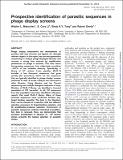Prospective identification of parasitic sequences in phage display screens
Author(s)
Li, Shuo C.; Matochko, Wadim L.; Tang, Sindy K. Y.; Derda, Ratmir
DownloadMatochko-2013-Prospective identifi.pdf (5.413Mb)
PUBLISHER_CC
Publisher with Creative Commons License
Creative Commons Attribution
Terms of use
Metadata
Show full item recordAbstract
Phage display empowered the development of proteins with new function and ligands for clinically relevant targets. In this report, we use next-generation sequencing to analyze phage-displayed libraries and uncover a strong bias induced by amplification preferences of phage in bacteria. This bias favors fast-growing sequences that collectively constitute <0.01% of the available diversity. Specifically, a library of 10[superscript 9] random 7-mer peptides (Ph.D.-7) includes a few thousand sequences that grow quickly (the ‘parasites’), which are the sequences that are typically identified in phage display screens published to date. A similar collapse was observed in other libraries. Using Illumina and Ion Torrent sequencing and multiple biological replicates of amplification of Ph.D.-7 library, we identified a focused population of 770 ‘parasites’. In all, 197 sequences from this population have been identified in literature reports that used Ph.D.-7 library. Many of these enriched sequences have confirmed function (e.g. target binding capacity). The bias in the literature, thus, can be viewed as a selection with two different selection pressures: (i) target-binding selection, and (ii) amplification-induced selection. Enrichment of parasitic sequences could be minimized if amplification bias is removed. Here, we demonstrate that emulsion amplification in libraries of ~10[superscript 6] diverse clones prevents the biased selection of parasitic clones.
Date issued
2013-11Department
Massachusetts Institute of Technology. Department of Biological EngineeringJournal
Nucleic Acids Research
Publisher
Oxford University Press
Citation
Matochko, W. L., S. Cory Li, S. K. Y. Tang, and R. Derda. “Prospective identification of parasitic sequences in phage display screens.” Nucleic Acids Research (November 11, 2013).
Version: Final published version
ISSN
0305-1048
1362-4962